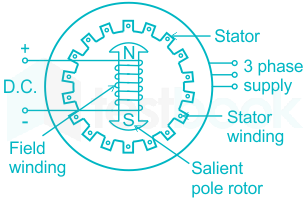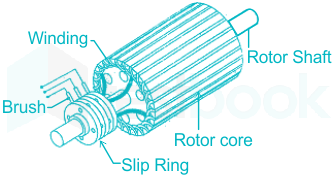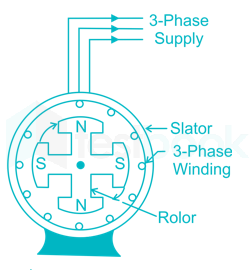Alternators MCQ Quiz - Objective Question with Answer for Alternators - Download Free PDF
The relationship between line and phase voltages and currents in star connected and delta connected networks are:
Relation between voltages
Relation between currents
India’s #1 Learning Platform
Start Complete Exam Preparation
Daily Live MasterClasses
Practice Question Bank
Mock Tests & Quizzes
Trusted by + Students
Alternators Question 2:
Which of the following is NOT true of parallel operation of alternators?
- Increase in reliability
- Increase in losses
- Increase in efficiency
- Proper load sharing
- Increase in flexibility
Answer (Detailed Solution Below)
Option 2 : Increase in losses
Alternators Question 2 Detailed Solution
The correct answer is option 2.
The parallel operation of alternators is necessary because:
- During periods of high load, several alternators operating in parallel can supply a bigger load than a single alternator whereas during periods of light load, one or more alternators may be shut down and those remaining to operate at or near full load, thus enabling p roper load sharing.
- When there is maintenance or an inspection, one machine can be taken out of service and the other alternators can keep up for the continuity of supply. It increases the reliability of the system.
- The losses in the system reduce, hence efficiency increases.
- The operating cost is reduced.
- It ensures the protection of supply and enables cost-effective generation.
India’s #1 Learning Platform
Start Complete Exam Preparation
Daily Live MasterClasses
Practice Question Bank
Mock Tests & Quizzes
Trusted by + Students
Alternators Question 3:
Alternators are usually designated to generate which type of AC voltage?
- with fixed frequency
- with variable frequency
- fixed current
- fixed power factor
Answer (Detailed Solution Below)
Option 1 : with fixed frequency
Alternators Question 3 Detailed Solution
Alternators are generally designed to supply electric power because of the following reasons.
- Constant Voltage
- Constant frequency
- Capability to deliver active as well as reactive power
India’s #1 Learning Platform
Start Complete Exam Preparation
Daily Live MasterClasses
Practice Question Bank
Mock Tests & Quizzes
Trusted by + Students
Alternators Question 4:
The efficiency ' \(\eta\) ' of a 3-phase alternator is given by:
- \(\eta = \over Output + Losses>\)
- \(\eta = \over Iutput + Losses>\)
- \(\eta = \over Output>\)
- \(\eta = \over Output + Losses>\)
Answer (Detailed Solution Below)
Option 1 : \(\eta = <\over Output + Losses>\)Alternators Question 4 Detailed Solution
Concept
A 3-phase alternator is an electrical machine that is used to convert mechanical energy into electrical energy.
The efficiency of a 3-phase alternator is given by:

India’s #1 Learning Platform
Start Complete Exam Preparation
Daily Live MasterClasses
Practice Question Bank
Mock Tests & Quizzes
Trusted by + Students
Alternators Question 5:
In synchronous machines, the salient poles are:
- rotating field winding
- stationary field winding
- rotating armature winding
- stationary armature winding
Answer (Detailed Solution Below)
Option 1 : rotating field winding
Alternators Question 5 Detailed Solution
Construction of synchronous machine

- An alternator consists of two parts, the stator, and the rotor.
- The stator is the stationary part of the machine, and the rotor is the rotating part of the machine.
- The stator carries the armature winding in which the voltage is generated, and the output is taken from it.
- The rotor of the machine produces the main flux.
- In synchronous machines, the salient poles are rotating field winding .
- The poles are magnetized either by permanent magnets or by a dc current.
- The armature, normally containing a three-phase winding, is mounted on the shaft.
India’s #1 Learning Platform
Start Complete Exam Preparation
Daily Live MasterClasses
Practice Question Bank
Mock Tests & Quizzes
Trusted by + Students
Top Alternators MCQ Objective Questions
Alternators Question 6
What happens when an alternator is said to be over excited?
- Negative power factor
- Unity power factor
- Lagging power factor
- Leading power factor
Answer (Detailed Solution Below)
Option 3 : Lagging power factor
Alternators Question 6 Detailed Solution
An overexcited alternator always supplies lagging current to the connected load, which means that load is of lagging nature. Lagging load take active and reactive power from the supply or alternator. Therefore, reactive power flows outwards from an over-excited alternator.
- Under excited alternator works at the leading power factor
- The normal excited alternator works at the unity power factor
- The overexcited alternator works at lagging power factor

Mistake Points For Synchronous motor its opposite of alternator,
- Under excited synchronous motor works at lagging power factor
- The normal excited synchronous motor works at the unity power factor
- The overexcited synchronous motor works at a leading power factor
Share on Whatsapp
India’s #1 Learning Platform
Start Complete Exam Preparation
Daily Live MasterClasses
Practice Question Bank
Mock Tests & Quizzes
Trusted by + Students
Alternators Question 7
In synchronous machines, the salient poles are:
- rotating field winding
- stationary field winding
- rotating armature winding
- stationary armature winding
Answer (Detailed Solution Below)
Option 1 : rotating field winding
Alternators Question 7 Detailed Solution
Construction of synchronous machine

- An alternator consists of two parts, the stator, and the rotor.
- The stator is the stationary part of the machine, and the rotor is the rotating part of the machine.
- The stator carries the armature winding in which the voltage is generated, and the output is taken from it.
- The rotor of the machine produces the main flux.
- In synchronous machines, the salient poles are rotating field winding .
- The poles are magnetized either by permanent magnets or by a dc current.
- The armature, normally containing a three-phase winding, is mounted on the shaft.
Share on Whatsapp
India’s #1 Learning Platform
Start Complete Exam Preparation
Daily Live MasterClasses
Practice Question Bank
Mock Tests & Quizzes
Trusted by + Students
Alternators Question 8
What is the efficiency of an alternator if the output is 25 kW and the loss is 2 kW?
- 80 percent
- 65.75 percent
- 75.68 percent
- 92.60 percent
Answer (Detailed Solution Below)
Option 4 : 92.60 percent
Alternators Question 8 Detailed Solution
The correct answer is option 4): ( 92.60 percent)
Concept:
The efficiency of the alternator is the ratio between the output to the Input
Efficiency = \(\frac \times 100\)
Output = Input - losses
Calculation:
Input = Output + loss
Efficiency = \(\frac \times 100\)
Share on Whatsapp
India’s #1 Learning Platform
Start Complete Exam Preparation
Daily Live MasterClasses
Practice Question Bank
Mock Tests & Quizzes
Trusted by + Students
Alternators Question 9
The percentage of voltage regulation formula of an alternator is
- \(\frac - V>>>> \times 100\)
- \(\frac - V>>\times 100\)
- \(\frac>>>> \times 100\)
- \(\frac + V>>\times 100\)
Answer (Detailed Solution Below)
Option 2 : \(\frac <- V>> \times 100\)Alternators Question 9 Detailed Solution
The voltage regulation of an alternator is defined as the ratio of the rise in voltage when full-load is removed (field excitation and speed remaining the same) to the rated terminal voltage.
% voltage regulation \( = \frac - V>> \times 100\)
Where E0 is the no-load voltage
And V is the rated voltage
Share on Whatsapp
India’s #1 Learning Platform
Start Complete Exam Preparation
Daily Live MasterClasses
Practice Question Bank
Mock Tests & Quizzes
Trusted by + Students
Alternators Question 10
In an alternator, field is placed on the rotor because of:
- large current in the stator
- large power in the stator
- insulation of voltage which is made easy on stator than on rotor
- small power in field circuit
Answer (Detailed Solution Below)
Option 3 : insulation of voltage which is made easy on stator than on rotor
Alternators Question 10 Detailed Solution
Advantages of the stationary armature and rotating field:
The field winding of an alternator is placed on the rotor and is connected to the DC supply through two slip rings. There are various advantages of the stationary armature and rotating field system.
- It is easier to insulate stationary winding for high voltages for which the alternators are usually designed.
- The stationary 3-phase armature can be directly connected to load without going through large, unreliable slip rings and brushes.
- Only two slip rings are required for DC supply to the field winding on the rotor. Since the exciting current is small, the slip rings and brush gear required are of light construction.
- Due to the simple and robust construction of the rotor, a higher speed of rotating DC field is possible. This increases the output obtainable for a machine of a given size.
- For large rating alternators, the construction of armature on the rotor becomes more complex.
Share on Whatsapp
India’s #1 Learning Platform
Start Complete Exam Preparation
Daily Live MasterClasses
Practice Question Bank
Mock Tests & Quizzes
Trusted by + Students
Alternators Question 11
The pitch factor of an alternator is defined as
Answer (Detailed Solution Below)
Option 2 : \(\rm\frac \)
Alternators Question 11 Detailed Solution
Concept:
- The coil span factor or pitch factor is defined as the ratio of the voltage generated in the short-pitch coil to the voltage generated in the full-pitch coil. The coil span factor is also known as the chording factor
- It can also be defined as the ratio of the vector sum of induced emf per coil to the arithmetic sum of induced emf per coil.
- Pitch factor = \(\rm\frac \)
Share on Whatsapp
India’s #1 Learning Platform
Start Complete Exam Preparation
Daily Live MasterClasses
Practice Question Bank
Mock Tests & Quizzes
Trusted by + Students
Alternators Question 12
The two methods of synchronising an alternator are?
- Loading effect and phase sequence
- Lamp method and synchoroscope method
- Two bright and one dark lamp method
- Hysteresis loss and friction loss method
Answer (Detailed Solution Below)
Option 2 : Lamp method and synchoroscope method
Alternators Question 12 Detailed Solution
Synchronization of alternator means connecting an alternator into the grid in parallel with many other alternators, that is in a live system of constant voltage and constant frequency.
Before connecting an alternator into the grid, the following conditions must be satisfied:
Equal voltage: The terminal voltage of incoming alternator must be equal to the bus-bar voltage.
Same frequency: The frequency of generated voltage must be equal to the frequency of the bus-bar voltage.
Phase sequence: The phase sequence of the three phases of alternator must be similar to that of the grid or busbars.
Phase angle: The phase angle between the generated voltage and the voltage of the grid must be zero.
The first condition of voltage equality can be satisfied by a voltmeter. To satisfy the conditions of equal frequency and identical phases, one of the following two methods can be used:
- Three Dark Lamps Method
- Two Bright, One Dark Method
- Synchroscope Method
Share on Whatsapp
India’s #1 Learning Platform
Start Complete Exam Preparation
Daily Live MasterClasses
Practice Question Bank
Mock Tests & Quizzes
Trusted by + Students
Alternators Question 13
The alternators in a generating stations are connected in
- Delta
- Star
- Star delta
- Double star
Answer (Detailed Solution Below)
Option 2 : Star
Alternators Question 13 Detailed Solution
The correct answer is option 2): Star
Concept:
The alternators in generating stations are connected in Star.
The economical and technical advantages of connecting alternators in the star are
- STAR connection provides a neutral point. This neutral point is very important from the stability point of view of the generator.So we can provide NCR grounding
- The insulation requirement in STAR connection is less. Since phase voltage is 1/√3 times i.e. 57.7% of the line voltage, therefore the insulation requirement of phase winding reduces. This is a great advantage from an economic point of view.
- STAR connection eliminates the third harmonics in the generated terminal voltage of generator armature winding
Share on Whatsapp
India’s #1 Learning Platform
Start Complete Exam Preparation
Daily Live MasterClasses
Practice Question Bank
Mock Tests & Quizzes
Trusted by + Students
Alternators Question 14
A 3 phase delta connected alternator having a rotating armature will have
- 2 slip rings
- 3 slip rings
- 4 slip rings
- 6 slip rings
Answer (Detailed Solution Below)
Option 2 : 3 slip rings
Alternators Question 14 Detailed Solution
Rotating Armature type alternator:

- In this type of alternator, the field winding is placed on the stator and armature winding on the rotating part that is the rotor.
- In the rotating armature type alternator, 3 slip rings for three-phase delta connection as shown in figure
- In this type of alternator, insulationcost is very high.
- There is a danger of damages in winding due to the high speed of the rotor.

Additional Information
Stationary Armature type alternator:
The field poles are placed on the stationary part of the machine. Since no commutator is required in an alternator, it is usually more convenient and advantageous to place the field winding on the rotating part (i.e., rotor) and three-phase armature windings on the stationary part (i.e., stator).

This arrangement has the following advantages:
1) The stationary armature coils can be insulated easily
2) Higher peripheral speed can be achieved in the rotor
3) Cooling of the winding is more efficient
4) Only two slip rings are required to give DC supply to the field system
5) Output current can be easily supplied to the load circuit







